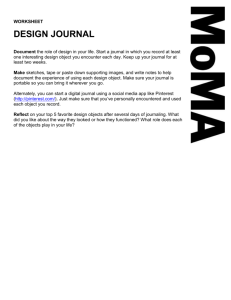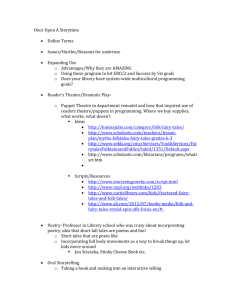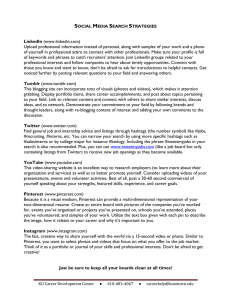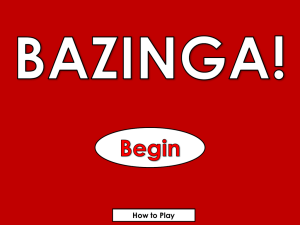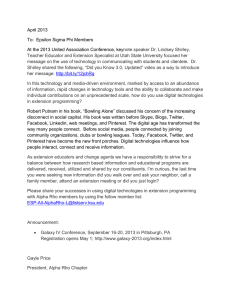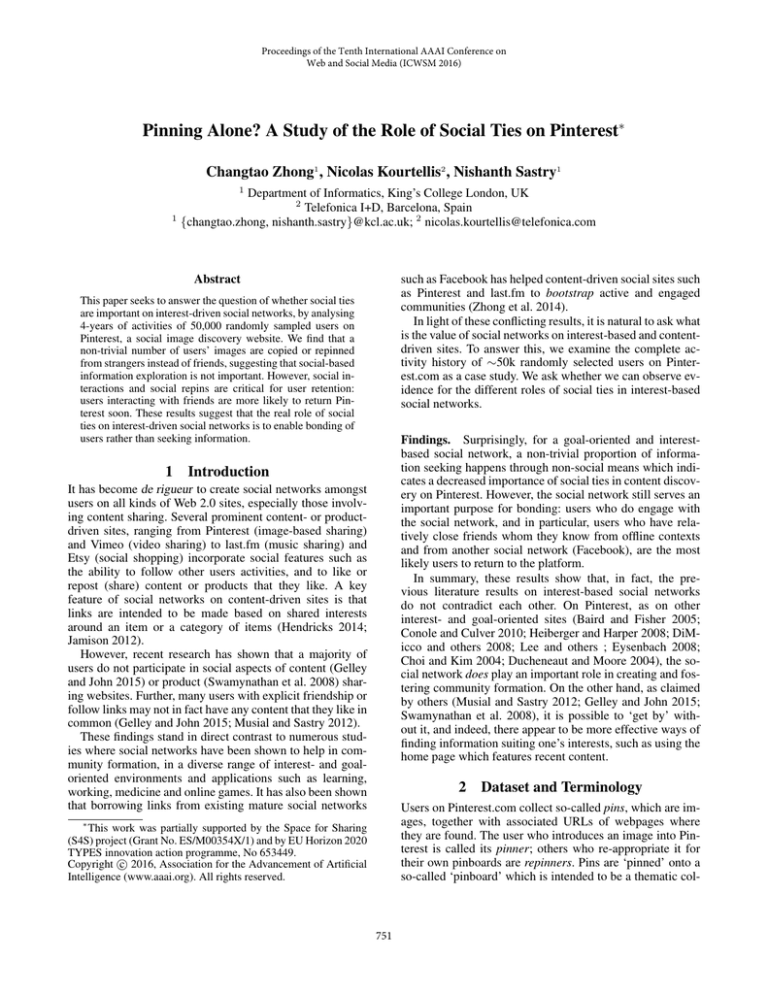
Proceedings of the Tenth International AAAI Conference on
Web and Social Media (ICWSM 2016)
Pinning Alone? A Study of the Role of Social Ties on Pinterest∗
Changtao Zhong1 , Nicolas Kourtellis2 , Nishanth Sastry1
1
1
Department of Informatics, King’s College London, UK
2
Telefonica I+D, Barcelona, Spain
{changtao.zhong, nishanth.sastry}@kcl.ac.uk; 2 nicolas.kourtellis@telefonica.com
such as Facebook has helped content-driven social sites such
as Pinterest and last.fm to bootstrap active and engaged
communities (Zhong et al. 2014).
In light of these conflicting results, it is natural to ask what
is the value of social networks on interest-based and contentdriven sites. To answer this, we examine the complete activity history of ∼50k randomly selected users on Pinterest.com as a case study. We ask whether we can observe evidence for the different roles of social ties in interest-based
social networks.
Abstract
This paper seeks to answer the question of whether social ties
are important on interest-driven social networks, by analysing
4-years of activities of 50,000 randomly sampled users on
Pinterest, a social image discovery website. We find that a
non-trivial number of users’ images are copied or repinned
from strangers instead of friends, suggesting that social-based
information exploration is not important. However, social interactions and social repins are critical for user retention:
users interacting with friends are more likely to return Pinterest soon. These results suggest that the real role of social
ties on interest-driven social networks is to enable bonding of
users rather than seeking information.
1
Findings. Surprisingly, for a goal-oriented and interestbased social network, a non-trivial proportion of information seeking happens through non-social means which indicates a decreased importance of social ties in content discovery on Pinterest. However, the social network still serves an
important purpose for bonding: users who do engage with
the social network, and in particular, users who have relatively close friends whom they know from offline contexts
and from another social network (Facebook), are the most
likely users to return to the platform.
In summary, these results show that, in fact, the previous literature results on interest-based social networks
do not contradict each other. On Pinterest, as on other
interest- and goal-oriented sites (Baird and Fisher 2005;
Conole and Culver 2010; Heiberger and Harper 2008; DiMicco and others 2008; Lee and others ; Eysenbach 2008;
Choi and Kim 2004; Ducheneaut and Moore 2004), the social network does play an important role in creating and fostering community formation. On the other hand, as claimed
by others (Musial and Sastry 2012; Gelley and John 2015;
Swamynathan et al. 2008), it is possible to ‘get by’ without it, and indeed, there appear to be more effective ways of
finding information suiting one’s interests, such as using the
home page which features recent content.
Introduction
It has become de rigueur to create social networks amongst
users on all kinds of Web 2.0 sites, especially those involving content sharing. Several prominent content- or productdriven sites, ranging from Pinterest (image-based sharing)
and Vimeo (video sharing) to last.fm (music sharing) and
Etsy (social shopping) incorporate social features such as
the ability to follow other users activities, and to like or
repost (share) content or products that they like. A key
feature of social networks on content-driven sites is that
links are intended to be made based on shared interests
around an item or a category of items (Hendricks 2014;
Jamison 2012).
However, recent research has shown that a majority of
users do not participate in social aspects of content (Gelley
and John 2015) or product (Swamynathan et al. 2008) sharing websites. Further, many users with explicit friendship or
follow links may not in fact have any content that they like in
common (Gelley and John 2015; Musial and Sastry 2012).
These findings stand in direct contrast to numerous studies where social networks have been shown to help in community formation, in a diverse range of interest- and goaloriented environments and applications such as learning,
working, medicine and online games. It has also been shown
that borrowing links from existing mature social networks
2
Dataset and Terminology
Users on Pinterest.com collect so-called pins, which are images, together with associated URLs of webpages where
they are found. The user who introduces an image into Pinterest is called its pinner; others who re-appropriate it for
their own pinboards are repinners. Pins are ‘pinned’ onto a
so-called ‘pinboard’ which is intended to be a thematic col-
∗
This work was partially supported by the Space for Sharing
(S4S) project (Grant No. ES/M00354X/1) and by EU Horizon 2020
TYPES innovation action programme, No 653449.
c 2016, Association for the Advancement of Artificial
Copyright Intelligence (www.aaai.org). All rights reserved.
751
(a)
(b)
(c)
Figure 1: Social network is not critical for information seeking on Pinterest: (a) The source of pins in our dataset. We examine
whether the pins are from the users themselves (“uploaded”), repinned from friends of the user (“social”), or repinned from
strangers (“non-social”). We term the first pins in users’ boards as “new board pins”, and the first pins of users in different
categories as “new category pins”. (b) Long-term dynamics of social vs. non-social repins, showing the proportion of social
and non-social repins vs. the “maturity” of user on Pinterest, as measured by the number of repins made since joining. Note
that there are fewer and fewer users as the “age” in terms of repin steps increases. (c) Pins on homepage are more similar to a
user’s recent pins than to his friends’ pins. For this study we use repin activities from (Zhong, Karamshuk, and Sastry 2015).
All of these pins were categorized using vectors constructed from 1000 objects detected on each pin, via Caffe (Jia et al. 2014).
Cosine similarity was computed at random time points between vectors of pins of users and (1) pins of their friends (marked as
“friends”) and (2) pins of random users featured on the homepage at that time (marked as “homepage”).
bitrarily chosen end date of April 1, 2014. To ensure that the
sample was as unbiased as possible, the user IDs were randomly sampled from a near complete snapshot of the Pinterest social network collected and provided by Zhong et
al. (Zhong et al. 2014) in Jan 2013. Thus, all users have at
least 15 months of activity on Pinterest. Some of these user
accounts have been suspended or deleted, and some have no
pins. This left us with 48,185 users, who collectively have
3.9 million social links and 10.3 million pins.
lection of related pins (e.g., one pinboard may have pins with
images of different wedding dresses.). Most of pinboards
are associated with one of 32 categories such as ‘Design’,
‘Products’, ‘Home Decor’, ‘Animals and Pets’, etc., which
are globally recognised on Pinterest.
Pinterest incorporates social networking features to allow users to connect with other users with similar interests.
Users can create connections to other users on Pinterest in
two ways. The first is to explore the website and follow users
they find interesting. We call social links created in this way
native links, as they are created natively on the platform. The
second way is using the “Find Friends” function. Users can
connect their Facebook and Twitter accounts with their Pinterest accounts and the Friend Finder function will provide
a list of Facebook and Twitter friends who are also registered on Pinterest. Users can select some of them to follow
on Pinterest, and create copied links1 .
To understand the effects of the social network on pinning, we distinguish and quantify the effects of pins involving the social network of the pinner, which we call social repins, from non-social repins, which involve users to whom
the pinner is not connected socially (i.e., repins of nonfriends or strangers). We further distinguish between repins
made from users who are friends with the original pinner as
native and copied, based on the type of friendship link. Note
that the nomenclature is always relative to the user who is
(re)pinning an image onto their own pinboard.
3
Do Social Ties help Information Seeking?
A core function of interest-based and content-driven sites
such as Pinterest is to enable users to find the information
that suits their interests. Therefore, we might expect that the
ability of social networks to provide access to new informationwould be important on Pinterest. To study this, we first
compare social vs. non-social means of acquiring new information.
Previous studies (Zhong et al. 2013; Zhong, Karamshuk,
and Sastry 2015) have found that creating new pins (or repins) is by far the most common activity on Pinterest, and
presents a quintessential information seeking activity. Users
may find out about the new pin externally to the website and
upload the pin themselves. Or, they may repin an existing
pin they find on Pinterest. In the latter case, they may repin
a pin from a friend of theirs (i.e., a social repin), or they may
repin an image pinned by someone with whom they are not
connected socially (i.e., a non-social pin). We check what
fraction of a user’s pins come from each of the three sources
– uploaded pins, social repins and non-social repins. In theory, each of these sources can be important to different extents in different kinds of information-seeking activities. For
instance, at the time of the first pin of a user in a new category, the user may be less knowledgeable about that category. Similarly, the first pin in a new board may be seen as
a new ‘sub category’ or thematic collection, and may have
Dataset. To analyse users’ activities and understand how
they accumulate and use social capital, we first created a
dataset by crawling the entire pinning activity history of
50,000 users from the time they joined Pinterest until an ar1
We will focus on the connection between Pinterest and Facebook in this study, as more than 60% of Pinterest users have connected with Facebook accounts, while only about 10% of users
connected to Twitter accounts (Zhong et al. 2014).
752
different information seeking patterns, in comparison with
subsequent pins.
We compare these different cases in Fig. 1a, across the
10.3 million images. Consistent with previous work (Zhong,
Karamshuk, and Sastry 2015), we find that uploads are fewer
in number than repins, whether social or non-social. However, the striking result is that across all kinds of information
seeking, whether for the first pins in new boards/categories,
or for subsequent pins, non-social means of finding information from other users dominate over social repins.
We then ask whether time matters: i.e., Do social repins
become more important as the user matures and conducts
more activities on Pinterest? Because the time between two
pins may be widely different across users, we measure user
age in terms of repin steps, the number of (re-)pins made
since joining Pinterest. In Fig. 1b we examine the entire history of activities of all users, as they “age” in Pinterest by
accumulating more activities. For each new repin activity of
a user, we check whether it is a social or non-social repin.
From the figure, we can see the proportion of social repins
is much larger than non-social repins when users just join
Pinterest. But the difference between the two proportions
is reduced as users become more experienced in the platform. This shows the growing importance of social repins
for users with large numbers of repins, and for users just
getting started on Pinterest (having very few repins), though
a non-trivial portion of repin activities is still non-social.
Such non-social repins are not hard to find: Pinterest highlights the most recent pins on the platform on its home page.
Fig. 1c shows that on average, the recent pins being highlighted on the home page at a given point in time are likely
to be more similar to user’s current interests than the recent
pins of the user’s friends. Thus, given access to the homepage which proves to be a simple and easy to find source
of interesting information, social-based information seeking
becomes less critical.
4
Figure 2: Social users are more likely to return: The retention rate of social users is significantly higher than for users
who have no social repins. Among users with social repins,
users who only have copied repins (C), i.e., those who have
only repinned their Facebook friends, are more like to return
than users who only have native repins (N), i.e., those who
have only repinned friends made on Pinterest. Users with
both types of repins (C&N) have the highest retention rate.
Fig. 2 shows the retention rates every week amongst different kinds of users. Apart from the annual drop in retention
rates corresponding to the holiday season at the end of the
year, retention rates for each kind of user stays at roughly
the same level throughout the year. First, we divide active
users in each week into social users and non-social users,
according to whether they have made any social repins in
the given week. These results show that retention of social
users is higher than non-social users. We find that only about
50% of users who have not made any social repins (“nonsocial”, black line) return to the platform within a week,
whereas more than 60% of users that interacted with their
social friends do return. This difference is statistically significant (p = 3.15 × 10−5 ). Thus we may conclude that
users with social interactions are more likely to return and
be engaged with the platform.
Furthermore, we divide social repins into copied and native repins according to whether friends are copied from
Facebook or met natively in Pinterest as discussed in § 2.
In Fig. 2, we can see that users who have a copied repin
(“C”, red line) have higher retention rate than users do native repins (“N”, green line). Users with both types of repins
(“C&N”, blue line) show the highest retention rates. Users
with both types of repins (21% of all users) contribute 71%
of Pinterest activities.
The Real Social Benefits of Pinterest
Given the finding that social links are not critical for identifying pins, the most critical activity on Pinterest, it is puzzling that its social network is counted amongst the fastest
growing across all platforms2 . In this section, we address the
issue of which users make social links, and why it is important. We find evidence the Pinterest social network is useful
for bonding and interaction.
4.1
4.2
Social users are more likely to return soon
It thus appears that social activities are important for the
platform to retain users. Yet, social assistance appears to be
less efficient than the homepage for individual users to find
pins suiting their interests and goals. To understand the role
of users’ social interactions, we divide their pin timelines
into “sessions”, drawing session boundaries whenever there
is a gap of T=6 hours or more between two consecutive pins.
Thus, a session is all pins which are “close” to each other in
time; similar results are obtained for other small values of T
(e.g., 1 or 3 hours), but are not reported due to space.
In each session, we define the major category as the category into which the user has repinned the most number of
images, and define the concentration level of this session
We start with a macro-scale analysis of users with different
kinds of social links, and check whether the active users are
also consistent, by measuring user retention. We follow Java
et al. (Java et al. 2007), and mark users who have an activity
in a given week as active. An active user is considered as
retained if she also pins or repins in each of following X
weeks. In our experiments, we measure the fraction of users
retained among all active users in each week. Due to space
constraints, we only show the results of X = 3, although
similar results can be obtain for X = {1, 2, 4}.
2
Social sessions are less goal-oriented
For example, see https://bitly.com/1MVk23k
753
References
Baird, D. E., and Fisher, M. 2005. Neomillennial user experience
design strategies: Utilizing social networking media to support “always on” learning styles. J. educ. tech. systems 34:5–32.
Burke, M.; Marlow, C.; and Lento, T. 2009. Feed me: motivating
newcomer contribution in social network sites. In CHI, 945–954.
Choi, D., and Kim, J. 2004. Why people continue to play online games: In search of critical design factors to increase customer
loyalty to online contents. CyberPsychology & behavior 11–24.
Conole, G., and Culver, J. 2010. The design of cloudworks: Applying social networking practice to foster the exchange of learning
and teaching ideas and designs. Computers & Education 54:679–
692.
DiMicco, J., et al. 2008. Motivations for social networking at work.
In CSCW. ACM.
Ducheneaut, N., and Moore, R. J. 2004. The social side of gaming:
a study of interaction patterns in a massively multiplayer online
game. In CSCW, 360–369. ACM.
Eysenbach, G. 2008. Medicine 2.0: Social networking, collaboration, participation, apomediation, and openness. Journal of Medical Internet Research 10.
Gelley, B., and John, A. 2015. Do i need to follow you?: Examining
the utility of the pinterest follow mechanism. In CSCW, 1751–
1762. ACM.
Heiberger, G., and Harper, R. 2008. Have you facebooked astin
lately? using technology to increase student involvement. New Directions for Student Services 2008(124):19–35.
Hendricks, D. 2014. Are interest-based networks the way of the future? http://www.forbes.com/sites/drewhendricks/2014/10/16/areinterest-based-networks-the-way-of-the-future/.
Jamison, J. 2012. Beyond facebook: The rise of interest-based
social networks.
Java, A.; Song, X.; Finin, T.; and Tseng, B. 2007. Why we twitter:
understanding microblogging usage and communities. In WebKDD
(SNA-KDD), 56–65. ACM.
Jia, Y.; Shelhamer, E.; Donahue, J.; Karayev, S.; Long, J.; Girshick,
R.; Guadarrama, S.; and Darrell, T. 2014. Caffe: Convolutional
architecture for fast feature embedding. In MM.
Lee, T. Y., et al. Experiments on motivational feedback for crowdsourced workers. In ICWSM.
Linder, R.; Snodgrass, C.; and Kerne, A. 2014. Everyday ideation:
All of my ideas are on pinterest. In CHI, 2411–2420. ACM.
Macskassy, S. A. 2012. On the study of social interactions in
twitter. In ICWSM. AAAI.
Musial, K., and Sastry, N. 2012. Social media: are they underpinned by social or interest-based interactions? In Proceedings of
the Fourth Annual Workshop on Simplifying Complex Networks for
Practitioners, 1–6. ACM.
Swamynathan, G.; Wilson, C.; Boe, B.; Almeroth, K.; and Zhao,
B. Y. 2008. Do social networks improve e-commerce?: a study on
social marketplaces. In WSON, 1–6. ACM.
Zhong, C.; Shah, S.; Sundaravadivelan, K.; and Sastry, N. 2013.
Sharing the loves: Understanding the how and why of online content curation. In ICWSM. AAAI.
Zhong, C.; Salehi, M.; Shah, S.; Cobzarenco, M.; Sastry, N.; and
Cha, M. 2014. Social bootstrapping: how pinterest and last. fm
social communities benefit by borrowing links from facebook. In
WWW.
Zhong, C.; Karamshuk, D.; and Sastry, N. 2015. Predicting pinterest: Automating a distributed human computation. In WWW.
Figure 3: Session concentration vs. social repin fraction:
Users tend to have more social repins in sessions without a
goal (lower concentration) than in sessions with higher concentration.
as the fraction of images of the session that have been repinned to the major category. We expect that the higher the
concentration level, the more likely users are to be searching for a specific category of information, and less likely
to be browsing casually, without a goal. For each browsing
session, we also compute the fraction of repins which are
social. In Fig. 3, we compare the concentration level and
social repin fraction. We notice that levels of less concentration are associated with higher levels of social repins, i.e.,
when users do casual browsing without a specific information seeking need, they are more likely to be social, whereas
when they have a specific information need, they are more
goal oriented and find the information they need through the
most efficient means (which may not be social). User interviews by Linder et al. (Linder, Snodgrass, and Kerne 2014)
have also identified a similar pattern, with two types of information seeking behaviour in Pinterest: (a) casual browsing,
when they do not have a particular goal in mind, and (b) specific searching, when users only respond to (repin) a specific
type of image.
5
Discussion
In this paper, we have used the complete activity history
of ∼50k randomly selected users to unpack the role and
utility of the social network on Pinterest. We find that a
non-trivial number of users’ images are copied or repinned
from strangers instead of friends, suggesting that socialbased information exploration is not important. However,
social users of Pinterest contribute the majority of activity, and have a higher probability of returning to the site.
Social links have a strong bearing on engagement and this
has been demonstrated in Facebook (Burke, Marlow, and
Lento 2009), Twitter (Macskassy 2012), etc. The present
work confirms this phenomenon on Pinterest as well, suggesting that bonding over social repins is important for the
platform’s functioning.
From the perspective of the platform operator and the collective community of users on the platform, the Pinterest
social network is critical for healthy operation and to drive
user activities. We may hypothesise that the social network
could also be useful from an individual user’s perspective,
because of positive feelings of engagement and social interaction; however this requires further research (e.g., through
user studies), to be confirmed.
754

